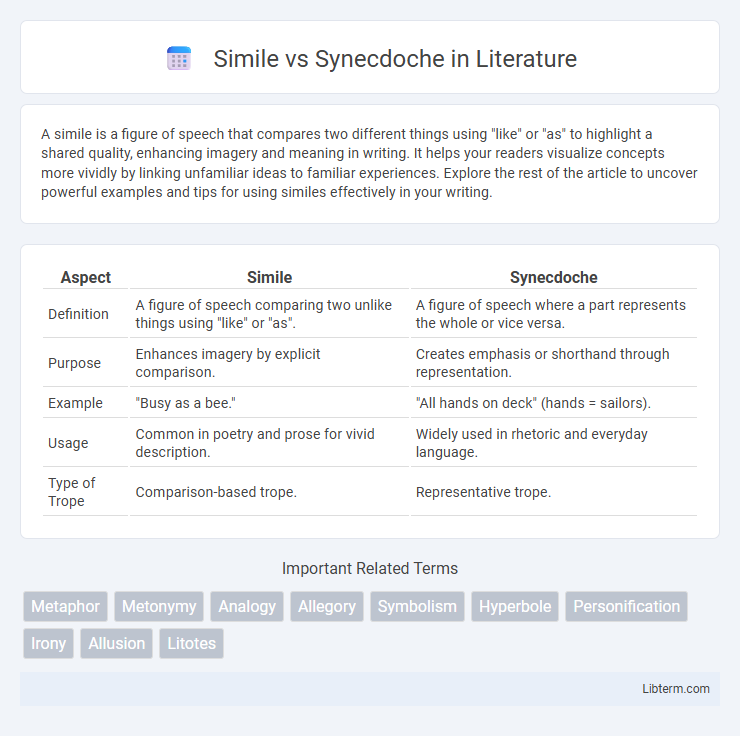A simile is a figure of speech that compares two different things using "like" or "as" to highlight a shared quality, enhancing imagery and meaning in writing. It helps your readers visualize concepts more vividly by linking unfamiliar ideas to familiar experiences. Explore the rest of the article to uncover powerful examples and tips for using similes effectively in your writing.
Table of Comparison
| Aspect | Simile | Synecdoche |
|---|---|---|
| Definition | A figure of speech comparing two unlike things using "like" or "as". | A figure of speech where a part represents the whole or vice versa. |
| Purpose | Enhances imagery by explicit comparison. | Creates emphasis or shorthand through representation. |
| Example | "Busy as a bee." | "All hands on deck" (hands = sailors). |
| Usage | Common in poetry and prose for vivid description. | Widely used in rhetoric and everyday language. |
| Type of Trope | Comparison-based trope. | Representative trope. |
Understanding Simile: Definition and Key Features
Simile is a figure of speech that explicitly compares two different things using connecting words such as "like" or "as," highlighting shared characteristics to create vivid imagery or emphasize a specific quality. Key features include its direct comparison, clarity, and ability to make descriptions more relatable and imaginative by linking unfamiliar concepts to familiar ones. Unlike synecdoche, which substitutes a part for the whole or vice versa, simile preserves both elements separately while drawing a clear parallel.
Exploring Synecdoche: Meaning and Characteristics
Synecdoche is a figure of speech in which a part of something represents the whole or vice versa, such as using "wheels" to refer to a car. This rhetorical device creates vivid imagery and concise communication by emphasizing a distinctive feature that symbolizes the entire object or concept. Unlike similes that explicitly compare two different things using "like" or "as," synecdoche relies on intrinsic relationships within the same entity to convey meaning and evoke deeper connections.
Historical Origins of Simile and Synecdoche
Simile traces its origins to ancient Greek rhetoric, where it was extensively used by Homer in epic poetry to create vivid comparisons using "like" or "as." Synecdoche originates from classical rhetoric as well, rooted in Greek and Latin traditions, employing a part-to-whole or whole-to-part relationship to convey meaning more powerfully. Both figures of speech have evolved through centuries, shaping literary and oratory techniques across cultures.
Main Differences Between Simile and Synecdoche
Simile and synecdoche are distinct figures of speech with different functions; simile explicitly compares two different things using "like" or "as" to highlight similarities, while synecdoche involves using a part to represent the whole or vice versa. Similes enhance imagery and clarify concepts by drawing direct comparisons, whereas synecdoche relies on a component or related attribute to symbolize a larger entity, often adding depth and layers of meaning. The main difference lies in simile's comparative nature versus synecdoche's representational substitution within language and literature.
Common Uses of Simile in Literature
Similes are frequently used in literature to create vivid imagery by comparing two different things using "like" or "as," helping readers visualize scenes and emotions more clearly. They often enhance descriptions of characters, settings, and moods by drawing imaginative parallels, such as "her smile was like sunshine." Unlike synecdoche, which substitutes a part for the whole or vice versa, similes maintain explicit comparisons, making them a popular tool for adding clarity and emotional depth in poetry, prose, and narrative storytelling.
Synecdoche in Everyday Language and Writing
Synecdoche frequently appears in everyday language and writing as a powerful rhetorical device where a part represents the whole, such as using "wheels" to refer to a car or "suits" to signify businesspeople. This figure of speech enriches communication by creating vivid, concise expressions that evoke broader concepts through specific components. Writers and speakers leverage synecdoche to add depth and relatability, making abstract ideas tangible and easily understood in daily conversations and literary contexts.
Examples of Simile vs. Synecdoche in Famous Works
Shakespeare's "Romeo and Juliet" uses simile in the line "It seems she hangs upon the cheek of night / Like a rich jewel in an Ethiope's ear," comparing Juliet's beauty to a jewel to create vivid imagery. In contrast, Herman Melville's "Moby Dick" employs synecdoche with the phrase "all hands on deck," where "hands" represents sailors, emphasizing collective action. These examples highlight how similes create direct comparisons to enhance description, while synecdoches use part-whole relationships to represent broader concepts or groups.
How to Identify Simile and Synecdoche in Texts
Identifying similes in texts involves looking for explicit comparisons using "like" or "as" to link two different things, emphasizing similarities. Synecdoche is recognized when a part represents the whole or vice versa, such as using "wheels" to refer to a car. Close attention to these linguistic markers helps distinguish similes' figurative comparisons from synecdoche's representational parts.
The Impact of Simile and Synecdoche on Reader Perception
Similes create vivid imagery by comparing two unlike things using "like" or "as," enhancing reader engagement through relatable and imaginative connections. Synecdoche uses a part to represent the whole or vice versa, prompting readers to think more deeply about the relationship between elements and enriching thematic depth. The distinct cognitive processing invoked by similes and synecdoche shapes emotional responses and influences how readers interpret textual meaning and symbolism.
Tips for Using Simile and Synecdoche Effectively
To use simile effectively, choose vivid and relatable comparisons that enhance imagery without overwhelming the reader, ensuring clarity and emotional impact. When employing synecdoche, select parts that strongly represent the whole, making the connection intuitive to your audience for deeper symbolic meaning. Combining precise, context-appropriate examples with balanced usage strengthens both simile and synecdoche in writing, enriching descriptive and rhetorical expression.
Simile Infographic

 libterm.com
libterm.com